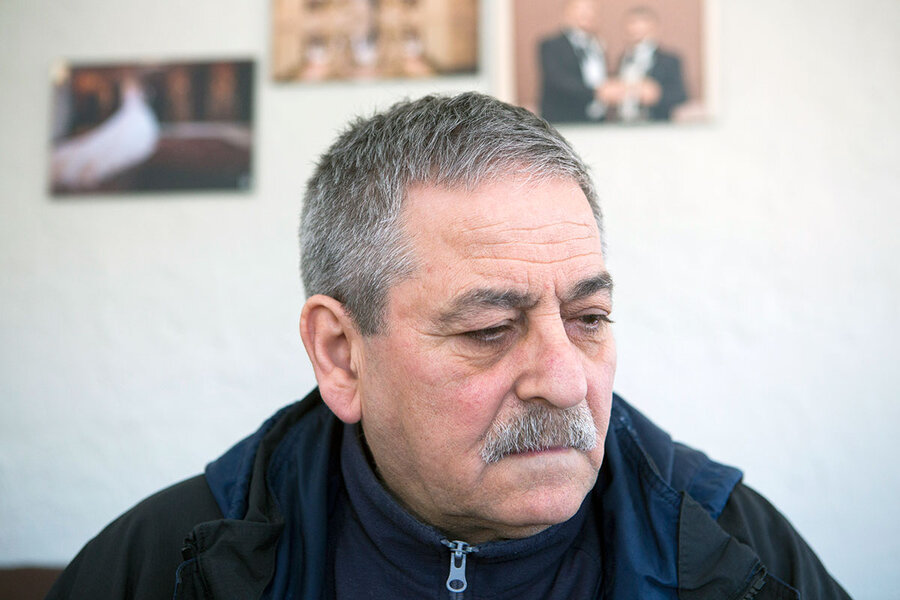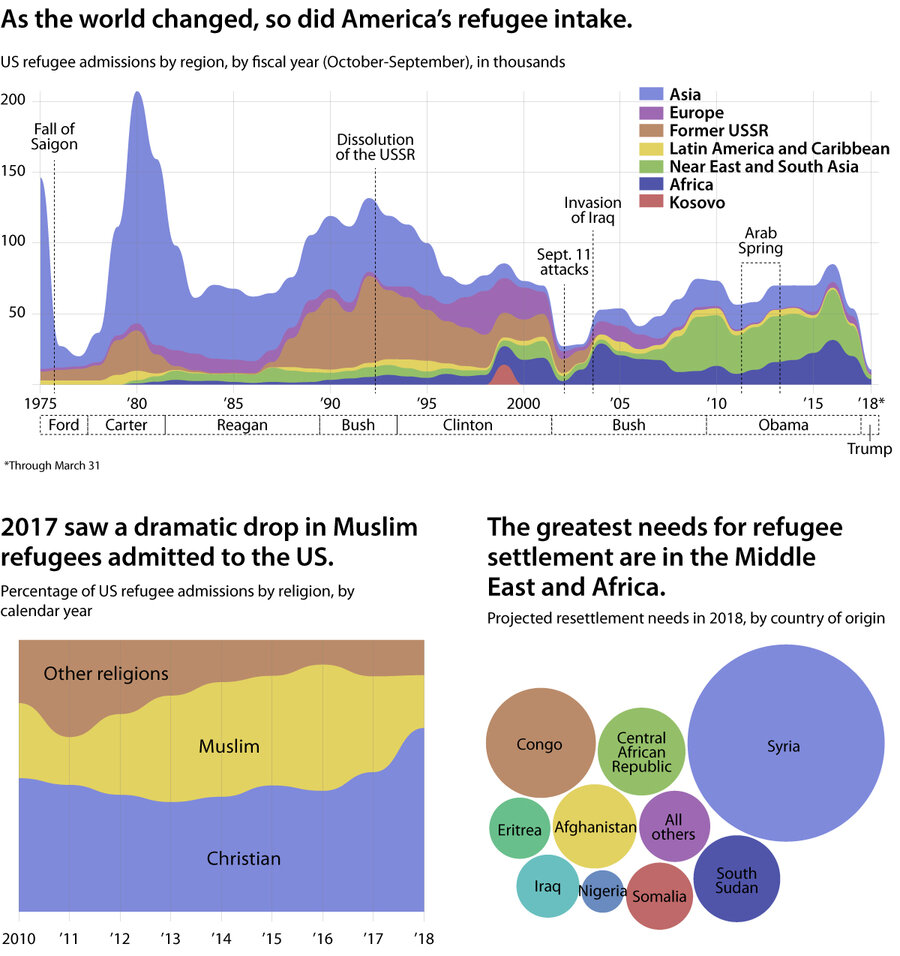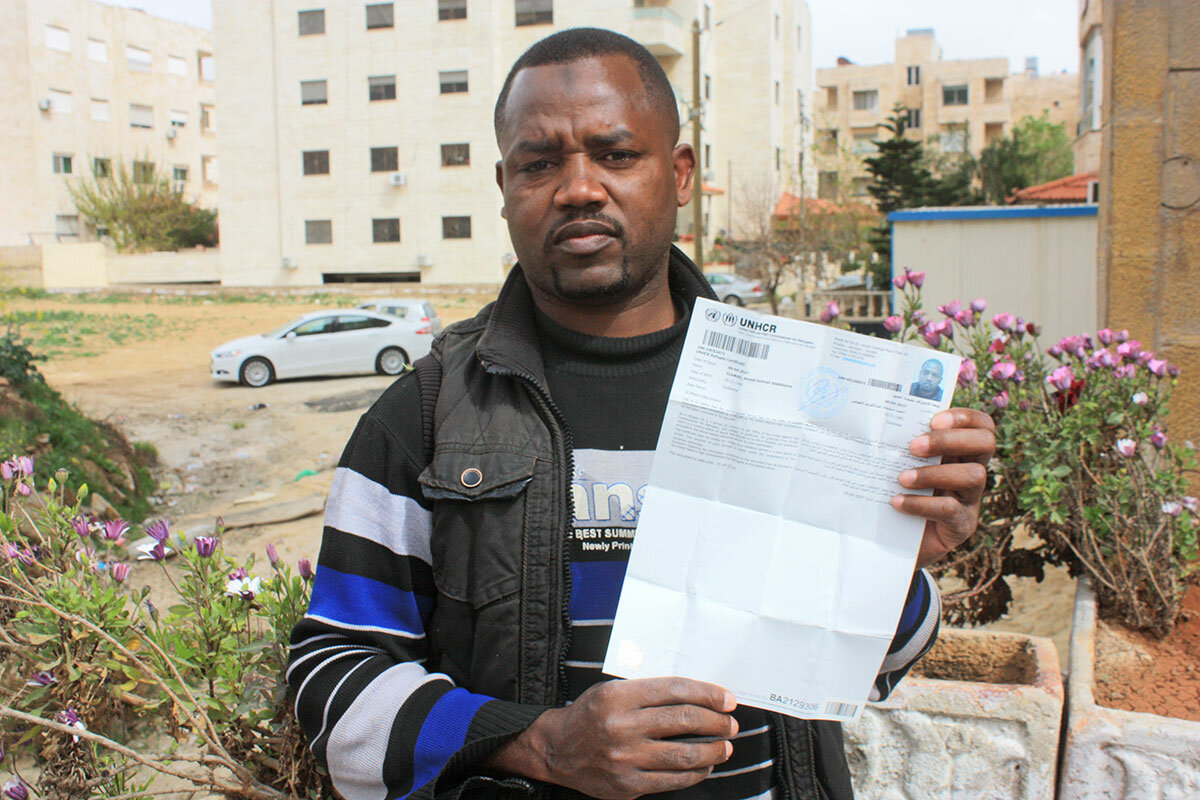US has cut inflow of refugees to a trickle, dousing hopes upstream
Loading...
| Foxborough, Mass., and Amman, Jordan
When Bassam Jalhoum’s oldest daughter, Rania, landed in Boston last October, it ended five years of waiting for her to complete her escape from Syria. “It was like a dream,” he says. “I was so happy.”
As a Syrian refugee admitted to the United States, Rania is among a fortunate few. She arrived on Oct. 24, the day when the Trump administration’s 120-day refugee ban ended, replaced by a new round of “extreme vetting” of Syrians and other nationalities. In the six months ending Mar 30, only 44 Syrian refugees were resettled in the US, a fraction of past admissions.
That clamp on refugee arrivals has put on hold Mr. Jalhoum’s dream of being reunited with two other children who, like Rania, had fled to Lebanon and applied for US resettlement.
“When I hear President Trump’s ideas about immigrants, I feel that I’m dying,” says Jalhoum, who immigrated to the US in 2000. “I’m afraid that my daughter and son will never come here.”
His fears are well grounded. Since Mr. Trump took office, refugee arrivals have slumped to historic lows. He has capped admissions for the year ending Sept. 30 at 45,000, down from an average of 95,000, and even that official ceiling is almost certain to be missed as a result of what rights groups, UN officials, and refugee agencies say is an unofficial go-slow policy.
“This administration doesn’t want refugees to come to the United States and are using every red-tape measure they have to slow down the flow of arrivals,” says Hans Van de Weerd, vice president of US programs at the International Rescue Committee, a New York-based nonprofit.
The throttling of refugee resettlement is part of a broader clampdown on immigrants from mostly Muslim countries via executive orders that have been challenged in federal courts. The Supreme Court begins hearings Wednesday into the latest travel ban that took effect in December, but not the legality of restrictions on refugees, in effect ceding to presidential power.
Even if the travel ban is ruled illegal – a verdict is expected by June – Trump can continue to put his America-First stamp on a refugee program that had long enjoyed bipartisan support in Congress and from US defense and diplomatic officials working in war-torn regions.
Far fewer Muslim refugees
That stamp means far fewer Muslim refugees and a larger proportion of Christians, including from Europe, for whom Trump expressed a preference in a meeting on immigration with lawmakers in January in which he derided migrants from nations in Africa and Central America. As a candidate, Trump called for a total shutdown on Muslims coming to the US.
Since October, refugee arrivals by region have fallen well short of the administration’s quota. Only one region was already close to its cap by the end of March: Europe, capped at 2,000, led by refugees from Ukraine, Russia, and Moldova, mostly white Christian countries.
Choking the overall pipeline of refugees means fewer federal dollars for the nonprofit agencies that are tasked with resettling them, which could make it harder to ramp up in the future under a more supportive administration. Local refugee agencies have cut staff and closed offices; nearly half of all resettlement agencies in Florida have shut down due to the drop in caseloads.
Before the 2016 election, 351 agencies worked on resettlements. A year later, around 100 had closed, says Jeffrey Thielman, chief executive of the International Institute of New England, which places refugees in Boston, Lowell, and Manchester, N.H. and is working with the Jalhoums.
Under Trump, the nativist wing of the Republican Party that wants both to slash legal immigration and expel undocumented residents has become ascendant. But the vexed politics in Congress on immigration reform has so far thwarted major changes. Refugees make an easier target since the president has discretion to set quotas and priorities for who comes to the US.
Shutting down the entire refugee program would require Congress to act, and there’s no sign of that happening, say refugee agencies. Instead, the administration is trying to gum up the process, a death by a thousand papercuts that is both constitutional and highly effective.
“They’re dragging their feet. They’re deliberately slowing things down,” says Mr. Thielman.
In Jordan, a long wait
In Jordan, where more than 1 million refugees have fled from wars in Syria, Iraq, Yemen, and Sudan, the US policy shift is stranding families, squeezing budgets, and dowsing hope.
Before Trump took office, the US had been the largest taker of refugees living in Jordan, so much so that other refugee-resettlement countries shifted their priorities to other countries. In 2016, the US took in 23,657 refugees from Jordan. Last year, it accepted 3,686, but many have yet to travel. UN officials privately say this year’s target of 3,000 is illusory; the real number could be closer to zero.
Under Trump, US Citizenship and Immigration Services staff who had previously worked in Jordan on a near-rotating basis to interview refugees – a critical first step toward acceptance – haven’t been in the country for nearly a year. The vast majority of those waiting for interviews today are refugees approved for resettlement under the Obama administration, before the travel bans and vetting changes. Refugee agencies now estimate that the average wait time to be resettled in the US has gone from 1.5 to 2 years to 3 to 5 years.
“These are all subtle ways to effectively kill the program while technically keeping it alive, and they are doing a fairly good job at finding them,” says Stephanie Gee, director of the Jordan office for the International Refugee Assistance Project, a US nonprofit.
Her advice to refugees who applied for US resettlement: Prepare for a long wait.
This was not the life Ahmed Suleiman imagined for himself in 2018. By now, he thought he would be resettled in Michigan, with his friends and sponsors, beginning a new life and sending money back to support his three young daughters in Sudan, where he is from. Having worked as an electrician, Mr. Suleiman aspired to train to be an auto electrician in Motor City, USA.
Instead, he’s holed up in a windowless vinyl-sided caravan on a trash-strewn, sandy parking lot in west Amman. It lacks electricity and water, even a bathroom. Suleiman, who is 37 and darker-skinned than most migrants from the Middle East, works illegally as a guard and janitor at three apartment buildings near his trailer. He can’t afford to pay $800 for a work permit so he risks being caught, and only makes $140 a month, when his employers don’t cheat him.
'Your file is pending'
What money he saves goes to his daughters – the youngest is 8 – who live alone in Khartoum, where they fled shortly before his wife died in Darfur. He says he received approval for resettlement in the US in October 2016. Since then his application has been on hold, subject to additional security vetting.
“I don’t want money, I don’t want a house or handouts,” says Suleiman. “All I want is a chance; I want my children to go to school and to be safe. Isn’t that the American dream?”
Every month, Suleiman goes to the UN refugee office in Amman to check on his application. Each time, he gets the same response, that his file is pending, security checks ongoing.
Sudan is among 11 mostly Muslim countries singled out by the Trump administration last October as posing additional security risks. Now refugees must provide 10 years of addresses, emails, social media accounts, and phone numbers for their entire family, up from five years previously. What often happens, say refugee agency officials, is that previous clearances expire before the process ends, so that applicants have to submit their paperwork again.
The White House has cited national security in its executive orders on immigration. From its viewpoint, the bureaucratic delays that refugees face are the “extreme vetting” that keeps out militants that may have eluded previous, less-stringent checks.
"We are not admitting into the country the very threats our soldiers are fighting overseas," Trump said last January after signing his first travel ban. "We only want to admit those into our country who will support our country and love deeply our people."
David Bier, a policy analyst at the Cato Institute in Washington, a think tank that supports higher levels of immigration, has looked for evidence to back up this justification. Using public databases and known terrorist incidents, he found that the risk of a vetting failure is vanishingly small, particularly since screening was greatly improved following the 9/11 attacks.
Only four individuals resettled as refugees since 9/11 have been convicted of terrorist offenses, according to Mr. Bier’s study, and none of their cases involved attacks or plots on US soil. “The actual threat needs to be computed in terms of the threat to American lives. It’s an incredibly small risk,” says Bier.
On the walls of his apartment in Foxborough, a town south of Boston where the New England Patriots play, Jalhoum has photos of his elder son’s church wedding in Lebanon (the family is Roman Catholic). Romeo married a Kuwaiti and lives there. Last year they had a son, a first grandchild.
Living alone, sending money to family
After her resettlement in October, Rania moved to Michigan to join her fiancé, a Syrian immigrant, so Jalhoum, who has cropped brown hair and a grey mustache, lives alone. His wife has a green card but she went back to Lebanon to be with Majd, the youngest daughter, and Eli, their son, while they wait for their papers.
Jalhoum works at a gas station, as he has done since moving to the US to find a better life and send money home for his kids’ education. Each day, he pulls on a Sunoco jacket and heads to work. But his heart is in Lebanon, with his family snared in a bureaucratic loop, unable to move.
“I don’t feel they are safe in Lebanon,” he says, noting that kidnappers target refugees with relatives in the US who might pay large ransoms.
Asked about Trump’s call for “extreme vetting,” Jalhoum says he supports doing everything possible to stop Islamic State and other militants. “You can’t tell which immigrants or refugees are terrorists. It’s hard,” he says.
What he finds harder to accept is why Majd and Eli, who applied at the same time as Rania, are being held up in Lebanon, why their applications haven’t been approved.
It’s a question that also plays on the mind of Suleiman, as he rests in his squalid trailer at the end of another long day.
Without a work permit, and unable to blend in due to his complexion and African features, he lives in fear of detention and expulsion. In 2015, Jordan rounded up 800 Sudanese men, women, and children, including UN-recognized refugees, and deported them to Sudan.
Deportation would spell the end to Suleiman’s dream of a new life. “We just want to tell the American people that we are not a threat or a drain on your resources. We only want to contribute to America, not take from it,” he says.







